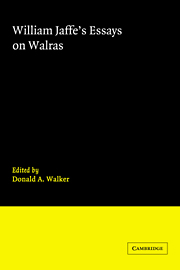Book contents
- Frontmatter
- Contents
- Preface
- Acknowledgments
- Introduction
- PART I WALRAS'S BIOGRAPHY
- PART II THE GENESIS AND DEVELOPMENT OF WALRAS'S IDEAS
- PART III THE SCOPE OF WALRAS'S WORK
- PART IV SPECIAL TOPICS IN WALRAS'S ECONOMICS
- 9 Léon Walras' theory of capital accumulation (1942)
- 10 Walras's theory of capital formation in the framework of his theory of general equilibrium (1953)
- 11 New light on an old quarrel: Barone's unpublished review of Wicksteed's “Essay on the coordination of the laws of distribution” and related documents (1964)
- 12 The Walras-Poincaré correspondence on the cardinal measurability of utility (1977)
- 13 Walras' theory of tâtonnement: a critique of recent interpretations (1967)
- 14 Another look at Léon Walras's theory of tâtonnement (1981)
- PART V WALRAS'S PLACE IN THE HISTORY OF ECONOMIC THOUGHT
- Index
14 - Another look at Léon Walras's theory of tâtonnement (1981)
Published online by Cambridge University Press: 05 May 2010
- Frontmatter
- Contents
- Preface
- Acknowledgments
- Introduction
- PART I WALRAS'S BIOGRAPHY
- PART II THE GENESIS AND DEVELOPMENT OF WALRAS'S IDEAS
- PART III THE SCOPE OF WALRAS'S WORK
- PART IV SPECIAL TOPICS IN WALRAS'S ECONOMICS
- 9 Léon Walras' theory of capital accumulation (1942)
- 10 Walras's theory of capital formation in the framework of his theory of general equilibrium (1953)
- 11 New light on an old quarrel: Barone's unpublished review of Wicksteed's “Essay on the coordination of the laws of distribution” and related documents (1964)
- 12 The Walras-Poincaré correspondence on the cardinal measurability of utility (1977)
- 13 Walras' theory of tâtonnement: a critique of recent interpretations (1967)
- 14 Another look at Léon Walras's theory of tâtonnement (1981)
- PART V WALRAS'S PLACE IN THE HISTORY OF ECONOMIC THOUGHT
- Index
Summary
Two considerations have prompted me to have another look at Léon Walras's (L. W.'s) theory of tâtonnement. One is my growing dissatisfaction with my own prior look that goes back to 1967 when my article, “Walras's Theory of Tâtonnement: A Critique of Recent Interpretations,” was published; the other is my present disagreement with Professor Michio Morishima's recent interpretation of the same theory in Chapter 2, “The Tâtonnement,” of his Walras' Economics: A Pure Theory of Capital and Money, published in 1977.
My purpose is not to pick a quarrel with Morishima's or anyone else's Walras-like theories of tâtonnement, which, indeed, are often better than the original, especially from the standpoint of econometrically motivated analysis. My sole aim is to show that the ‘present-mindedness’ of our contemporaries tends to blind them to the original purport of past texts. The principle of historical integrity is too dear to the heart of a practiced historian to allow textual misinterpretations (his own included) to pass unnoticed.
L. W. could not have found a better label than tâtonnement to attach to his theory of the emergence of multi-market equilibrium. It describes perfectly how he reached for the theory, though it is a misnomer for the theory itself, especially in its definitive version. From edition to edition of the Eléments, beginning with the first part of the first edition of 1874–1877, he groped and groped for an answer to his problem, and, in the end, he shifted his ground and actually, perhaps without quite realizing it, gave up the quest.
- Type
- Chapter
- Information
- William Jaffe's Essays on Walras , pp. 244 - 266Publisher: Cambridge University PressPrint publication year: 1983
- 2
- Cited by



